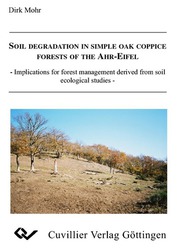| Departments | |
|---|---|
| Book Series (96) |
1378
|
| Nachhaltigkeit |
3
|
| Gesundheitswesen |
1
|
| Humanities |
2364
|
| Natural Sciences |
5406
|
| Mathematics | 229 |
| Informatics | 319 |
| Physics | 980 |
| Chemistry | 1363 |
| Geosciences | 131 |
| Human medicine | 243 |
| Stomatology | 10 |
| Veterinary medicine | 108 |
| Pharmacy | 147 |
| Biology | 835 |
| Biochemistry, molecular biology, gene technology | 121 |
| Biophysics | 25 |
| Domestic and nutritional science | 45 |
| Agricultural science | 1004 |
| Forest science | 201 |
| Horticultural science | 20 |
| Environmental research, ecology and landscape conservation | 148 |
| Engineering |
1793
|
| Common |
98
|
|
Leitlinien Unfallchirurgie
5. Auflage bestellen |
|
Advanced Search
Soil Degradation in simple Oak Coppice Forests of the Ahr-Eifel (English shop)
Dirk Mohr (Author)Preview
Table of Contents, Datei (83 KB)
Extract, Datei (500 KB)
Simple oak coppice forests of the Ahr-Eifel are confronted with extensive soil degradation. Four complementary investigations were conducted to study the impact of the environmental factors “relief position”, “slope gradient”, “red deer”, “wild boar”, “stand density” and “stand composition” on soil degradation in the investigation area. Soil quality was assessed determining several physical, chemical and biotic soil properties in the upper soil (Ah-horizon) of twelve different oak forest sites. Relief position and slope gradient influenced soil degradation in the investigation area. The content of basic cations (K+, Ca2+, Mg2+) was significantly lower, the content of Al3+ significantly higher at leeward slopes than at windward slopes. Soil nutrient contents were lower and the Al3+ content higher at the slope position “plateau” and at sites with high slope gradients than at the foot slope and sites with low inclinations. Red deer grazing and trampling enhanced soil degradation at a windward forest site. Soil moisture, water retention capacity (WRCmax), nutrient availability and microbial activity were lower under the impact of red deer than in fenced exclosures. Opposite tendencies were found at a leeward forest site. The content of several soil nutrients and microbial characteristics were higher outside the fenced exclosure. The abundance of several soil invertebrates was clearly reduced at the unfenced plots of both slope aspects.
| ISBN-13 (Printausgabe) | 3865370144 |
| ISBN-13 (Hard Copy) | 9783865370143 |
| ISBN-13 (eBook) | 9783736910140 |
| Language | German |
| Page Number | 146 |
| Edition | 1 |
| Volume | 0 |
| Publication Place | Göttingen |
| Place of Dissertation | Göttingen |
| Publication Date | 2004-03-01 |
| General Categorization | Dissertation |
| Departments |
Agricultural science
|








